It is always interesting when murmurs of disapproval and controversy greet a new production before it even opens. When an e-mail was circulated by the Royal Opera House warning patrons of interpolated scenes of sex and violence in Katie Mitchell’s production of Donizetti’s Lucia di Lammermoor, righteous indignation pre-emptively arose in certain quarters. Ms. Mitchell is a director little known for her subtlety or flair for tradition, and the worst was quickly assumed.
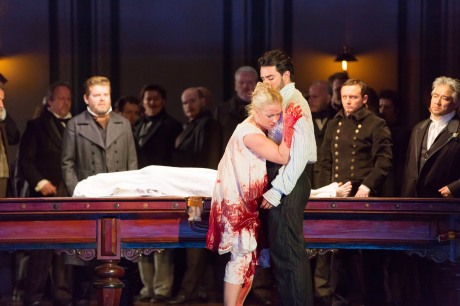
In the event, perhaps the most surprising thing about the production was just how uncontroversial it actually was; if anything, the evening, overwrought with ill-conceived ideas and not sufficiently trusting in the power of Donizetti’s music, was far duller than the work itself warrants—though the blame for this also lay in the hands of somewhat leaden conducting. Nevertheless, for all the seeds of discontent, the performance proved a reasonably standard example of a strong cast of singers bringing light to an otherwise misguided, if not especially shocking production.
The work itself is adapted from Sir Walter Scott’s 1819 novel The Bride of Lammermoor. Its tale of gothic romance about two warring families and the illicit love between the daughter of one and the son of the other seems tailor made for the stuff of nineteenth-century Italian opera. Donizetti turned to Salvadore Cammarano for the libretto, beginning a relationship that would proceed through several operas including Roberto Devereux and Poliuto. The focal point of the work is the eponymous bride of Lammermoor, Lucy Ashton, compelled to renounce the man she loves and marry another. Descent to madness and the murder of her new husband follow. Ms. Mitchell is known for what she herself terms her ‘feminist agenda’; whether or not one feels narrow agendas have any place in intelligent direction, Lucia is certainly a work that offers vivid illustration of the plight of a woman who finds herself with little autonomy, crushed by the patriarchal system into which she is born.
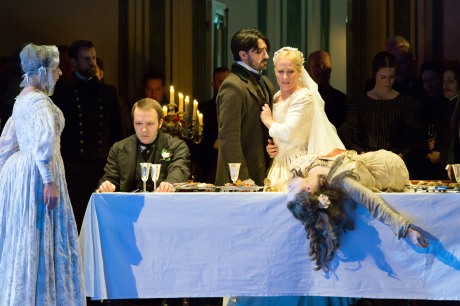
As often seems to be in directorial fashion these days, the production is set not at the time of the work itself but rather at approximately the premiere of the opera, transposing it from the sixteenth-century to the nineteenth. This does little to elucidate the story, and if anything detracts from the underlying sense of danger that should be associated with the violent ancestral feud at the heart of the story, which feels anachronistic in the decorous Victorian setting.
The updated chronology does provide the focus for the often sumptuous period set design of Vicki Mortimer. The opera opens on an elaborate graveyard flanked by a looming crypt, a staircase rising into the Ashton Castle, and stone angel presiding over a tomb; the other side of the stage features Lucia’s bedroom, bright parquet flooring adjoined by a large wardrobe. The costumes similarly bear out the Victorian theme. When she isn’t donning trousers and a heavy frock coat to sneak out of the castle incognito, Lucia wears a floating white dress, soon to be coated in blood. The men all look rather glum and indistinguishable in their prim black coats, but I suppose that is meant to be the point; the patriarchy blends together. This seemed a shame where it took away from the individuation between the characters; Edgardo should be a very different kind of man to Enrico Ashton, though in this case he looked pretty much the same as every other Victorian exemplar of societal patriarchy on stage.
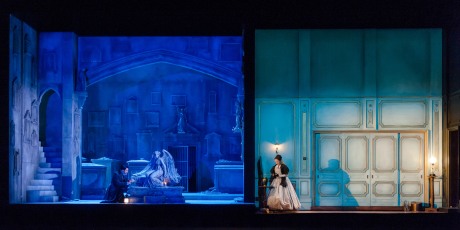
The production’s essential conceit bifurcates the stage into two halves split directly down the middle. Other than offering terrible sightlines to those siting on the sides of the theatre, this provides an almost constant stream of distractions occurring on one side of the stage while the cast tries to sing and act out the plot on the other. Mitchell has said the idea was born from the desire to show us what is not actually portrayed in Donizetti’s libretto—chiefly, the murder of Arturo that bears out Lucia’s mental collapse. Dividing the stage into discrete parts allows this scene to be brought to life even as the opera proceeds as written in the other half.
The problem is that the dramatic thrust of the opera is severely compromised by the constant stream of distractions occurring on the other side of the stage. Act III, for example, opens with the Wolf’s Crag confrontation between Edgardo and Enrico and featured riveting singing and acting by both male leads. Yet one was scarcely aware of the bulk of their duet, confronted as we were next door by the semi-comical staging of a scene which was not intended to be staged—the murder of Arturo. Peals of laughter rang through the theatre as Lucia and her maid Alisa fought to kill the unfortunate husband as he struggled and thrashed and simply refused to die. The exaggerated acting and protracted length of the scene did little to imbue any immediacy to the violence of the action; instead, viewing the unwritten scene not only distracted all attention from the excellent singing occurring on the other end of the stage, it robbed Lucia’s descent into madness of its mystery and horror.
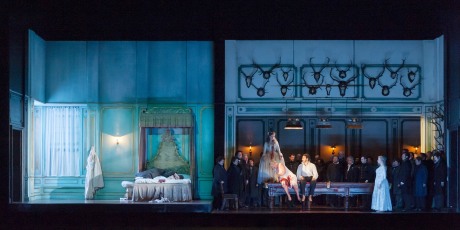
Often the most gruesome actions in the theatre are those which are too terrible to be witnessed on stage; audience conjecture into the unknown is a powerful directorial tool. Instead, in this as in everything else, Ms. Mitchell was committed to laying bare every insinuation and leaving nothing to subtlety or imagination. So we have Arturo’s murder acted out in comedic fashion when it would have been far more potent simply to witness the devastation it wreaks in Lucia’s mind. Similarly, when Lucia sets the tone of the first act and the events to come by mentioning a ghost she has seen, the production has a ghost visible on stage following her around for quite nearly every scene. This ghost is joined in Act II by the ghost of Lucia’s mother; together, they haunt the rest of the opera and our patience from that point onward, constantly clambering in through windows and casting themselves over set pieces. It was all too much unnecessary distraction, much ado about nothing on the operatic stage.
Which is genuinely a shame, as such an onslaught of overwrought imagery was unnecessary in the midst of such expressive music. Diana Damrau was mostly outstanding as the doomed heroine Lucia; she sounded a little tentative at first, yet her ‘Quando rapito in estasi’ became a joy and her performance took off from there. She did the best she could with Mitchell’s characterisation of the rule, bringing a modern rebelliousness to the character’s steely inner strength, even as this fades to desperation. Once she hit her stride, her agile coloratura soared through Donizetti’s tortuous vocal writing, her electrifying high notes frequently providing the dramatic thrust that was too seldom present in the orchestra.
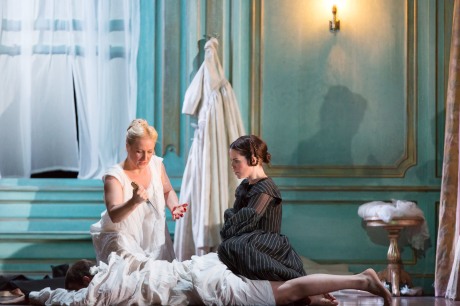
Mitchell’s production finds her pregnant following an Act I tryst and suffering a miscarriage—another overplaying of the directorial hand that did little to better the character’s psychology—and to her credit, Ms. Damrau threw herself vividly into all that was asked of her on stage. Despite not always having the most intuitive or compelling orchestral accompaniment, she sang Lucia’s mad scene with conviction and some delicate but exquisite high notes. The glass harmonica that accompanied her brought mounds of atmosphere and was one of the stars of the evening.
Her Edgardo was Charles Castronovo, a familiar face at Covent Garden who nevertheless managed to surprise in the sheer lyricism of his singing. His tenor was at times tender and lovely, at others suffused with ardour; his Act I duet with Ms. Damrau was riveting, both performing admirably even as they were forced to undress and simulate a sexual act in tune with the music but utterly out of place within the story’s context. The luxuriant beauty of his tenor was the high point of the opera’s final scene. ‘Tu che a Dio spiegasti l’ali’ was one of the few points of the evening that was genuinely moving, and a fitting end to the performance.
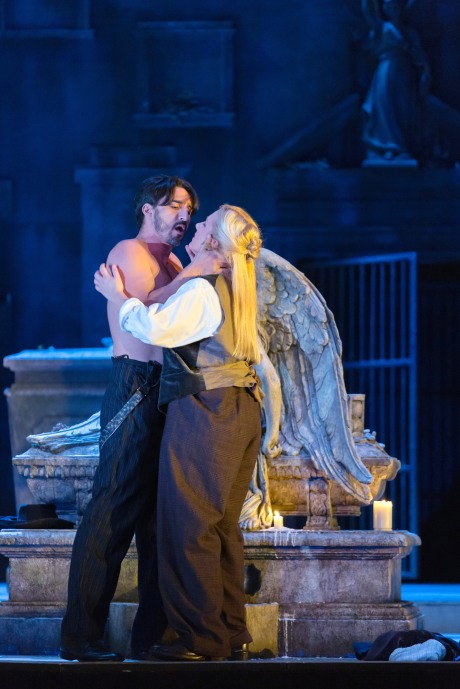
The rest of the cast was generally superb. Ludovic Tézier was one of the evening’s highlights as Lucia’s domineering brother Enrico, and the marvellous Kwangchul Youn brought presence to the chaplain Raimondo Bidebent. Both possess baritones of exceptional lyricism and resonance; Mr. Tézier gives us much to look forward to as he returns to Covent Garden next season to sing Posa and Iago.
Peter Hoare was an excellent Normanno, and Taylor Stayton was fine in the relatively thankless role of Arturo. Rachael Lloyd sang beautifully as Alisa, and acquitted herself well of the myriad stage-business that was thrown her way by virtue of her being the only woman besides Lucia on stage, and therefore at the centre of Ms. Mitchell’s feminist concept. Yet one does not need to try quite so hard to imbue feminist overtones into the opera; masculine oppression is everywhere in the text itself. Many of this production’s ideas are sound, but a little nuance would have gone a long way.
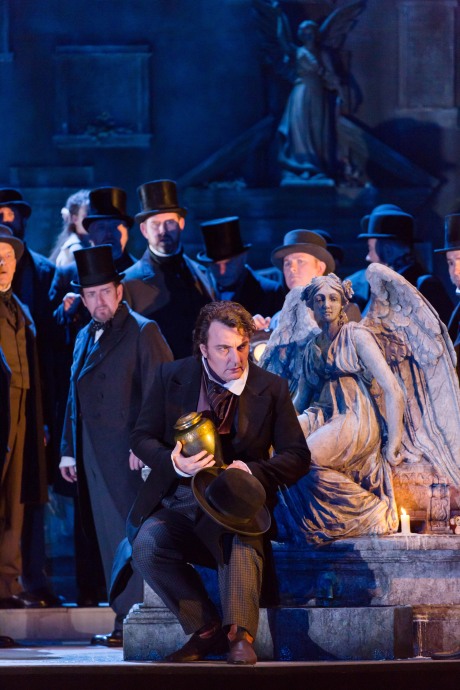
As usual, The Royal Opera Chorus sounded great; the Act II scene in the castle hall where the wedding guests welcome Arturo was particularly stirring. The orchestra played well, but the sluggish conducting of Daniel Oren did it no favours. A disconnect seemed to divide the orchestra from the stage far too often, and where the singers—notably Mr. Tézier, Mr. Youn, Ms. Damrau, and Mr. Castronova—were capable of lifting the performance into the realm of great drama, rarely did this feel matched by shared impetus in the orchestra. This was a pity, as despite the overload of ideas plaguing Ms. Mitchell’s staging, had the orchestra been equal to the singers, it could still have been a fine production.
As it transpired, opening night was unusually insipid, neither the able cast nor the thunderous boos that greeted the director capable of redeeming the night from the realm of the unaffecting and the leaden.
2 stars
John E. de Wald
(Photos :
As usual with these sick sister directors, this looks like another vast waste of precious funds on an egomaniacal production that serves no purpose other than to feed the twisted ego.